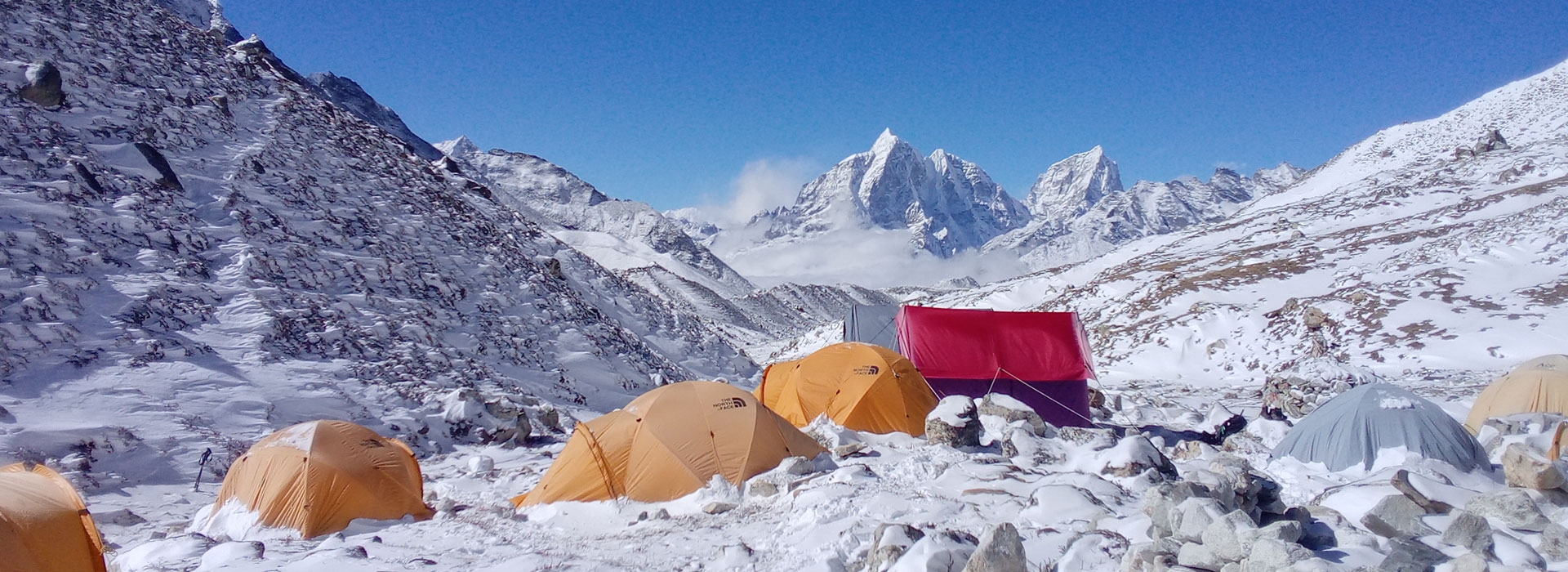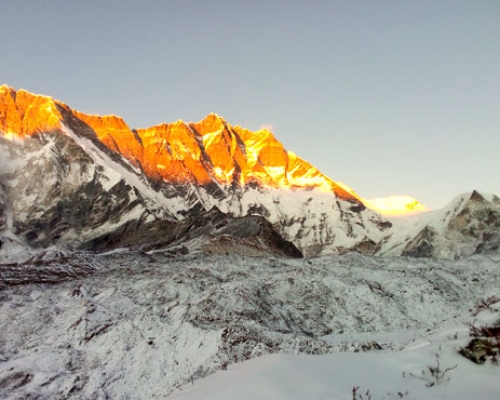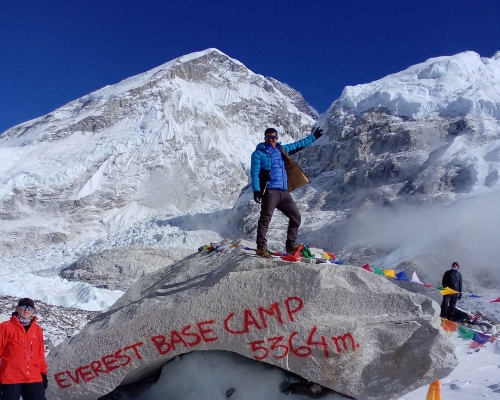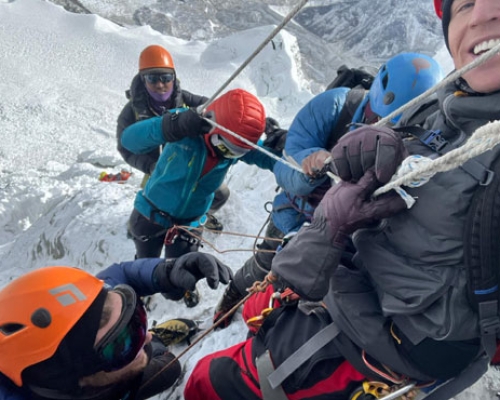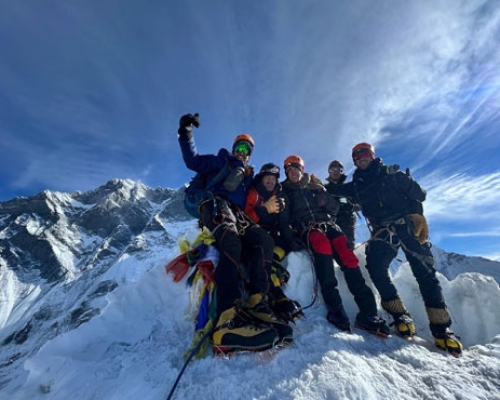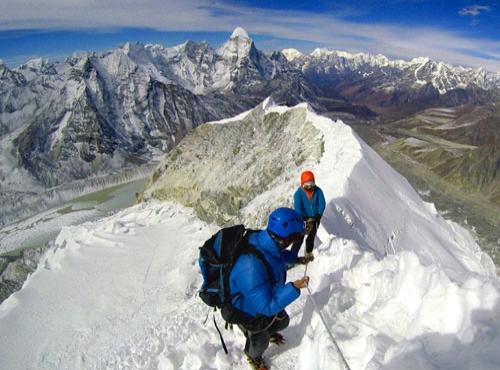"Embark on a 22-day Lobuche East and Island Peak Expedition in Nepal, a lifetime venture amidst giant Himalayan mountains and lovely mountain people. Test your endurance, push yourself and enhance your climbing skills with our expert on-field supporting crew." - Scenic Neppal Treks
Lobuche east and Island peak expedition combines summits of two famous trekking peaks in the eastern Himalayas of Nepal. You'll scale two 6,000 meters above the peak under the guidance of top climbers. Lobuche East (6,119 m) and Island Peak (6,160 m) both offer a great introduction to peak climbing in Nepal, especially to beginner climbers. You'll need a high level of cardiovascular fitness to do the Lobuche east and Island peak expedition for 22 days. The best thing about this climbing package is it doesn't demand advanced mountaineering skills.
The Lobuche east and Island peak expedition in Nepal will help you sharpen your climbing skills. You'll learn a lot about technical climbing and test your endurance. Our advanced team will fix the ropes and give you pre-climbing training to boost your confidence. You'll be accompanied by an experienced team, so you do not have to worry about anything in the mountains. Our team will take care of you and your needs. We'll do our best to offer you a smooth peak climbing experience with us.
Combining the Lobuche Peak, Island Peak, and Everest Base Camp trek in Nepal is a challenging and adventurous journey that offers a unique opportunity to explore the Khumbu region and experience the majestic Himalayas. Here's some information about each of these treks and how they can be combined:
Everest Base Camp Trek:
The Everest Base Camp trek is one of the most popular treks in Nepal. It takes you to the base camp of Mount Everest, the highest peak in the world. This trek usually begins with a flight to Lukla and follows the classic route through picturesque Sherpa villages, lush valleys, and high-altitude landscapes. The trek offers stunning views of Everest, as well as other towering peaks in the region.
Lobuche East and Island Peak Expedition Trekking part
The initial part of the journey involves trekking through lush rhododendron and magnolia forests, picturesque Sherpa villages, lovely valleys, and verdant foothills. You spend nights in remote villages like Phakding (2,610 m), Namche Bazaar (3,440 m), Tengboche (3,860 m), Dingboche (4,340 m), Lobuche (4,940 m), and Chhukung (4,730 m). This part of the venture offers a good insight into the daily life of the locals and their rich cultural heritage. You'll be visiting ancient monasteries like Tengboche & Pangboche.
Along the adventurous trekking route, high Himalayan mountain views will accompany you. You get to see panoramic vistas of Everest (8,848.86 m), Lhotse (8,516 m), Cho Oyu (8,188 m), Makalu (8,463 m), Kanchenjunga (8,586 m), Nuptse (7,861 m), Chamlang (7,319 m), Pumori (7,161 m), Island Peak (6,160 m), Ama Dablam (6,812 m), Thamserku (6,608 m), and numerous others. Similarly, you'll enjoy many gorgeous sunrises and sunsets along the trail.
Before you move towards climbing Lobuche Peak and Island Peak, you explore the Everest base camp (5,364 m), the lap of Mt. Everest, the highest mountain in the world. And hike to Kala Patthar (5,644 m) and Chhukung ri (5,546 m). The views along the way are breathtaking. You'll gradually gain elevation and acclimatize too. We have ample acclimatization days in our Lobuche east and Island peak expedition itinerary that'll let you slow down and soak in the fresh mountain air.
Lobuche peak climbing
Lobuche Peak is situated between the Cho La pass and the Everest base camp. Lobuche has two summits- Lobuche East (6,119 m) and Lobuche West (6,145 m). We’ll climb Lobuche east, which is a trekking peak. Lobuche west is much more technical and considered an expedition peak. The peak stands above the Lobuche village and Khumbu Glacier. Mt. Everest and Mt. Lhotse is located 13.5 km east of Lobuche peak.
Climbing Lobuche peak is not that difficult if we take the technical aspect into consideration. However, the route to the summit does involve a steep slope, an ice wall, and numerous crevasses. From the Lobuche base camp, you'll ascend to the Lobuche high camp. The summit is located very close to the high camp. You walk on the sharp snow ridge and turn northwest. Just below the summit, there is a 45° slope. Crossing this section is quite difficult.
Island peak climbing
Island peak is known as Imja Tse in the local language. It is one of the most sought-after trekking peaks in the Khumbu region. Island Peak climbing is suitable for first-time climbers and doable with the support of a strong climbing team. Standing 6,160 meters above the sea, the Island peak is graded as Alpine PD+. Even though summiting this peak is not technically challenging but demands good physical fitness.
From Chhukung village, we walk on a steep path following the main valley. The tail ascends through the Lhotse Glacier moraine southern flank. Further, we cross the Imja and Lhotse glacier moraines to reach the Island peak base camp. On the summit push day, we wake up around midnight and begin preparing. We walk on a rocky ridge to a glacier. Above the ridge is a steep snow headwall that leads to the summit of Island Peak. The final climb includes a 60° to 70° slope to the summit ridge.
It's important to note that attempting these peaks requires mountaineering experience, physical fitness, and the necessary climbing equipment. It's recommended to join a reputable trekking agency that can provide experienced guides and support throughout the journey. Additionally, it's crucial to acclimatize properly to the altitude and be prepared for variable weather conditions in the Himalayas.
Overall, combining the Lobuche Peak, Island Peak, and Everest Base Camp trek is a thrilling and demanding adventure that offers a unique blend of trekking and mountaineering experiences in the iconic Everest region of Nepal.
You can also do Island peak climbing separately with us. Likewise, we also have Mera Peak climbingand Pisang Peak climbing.
